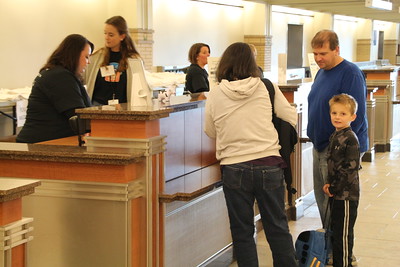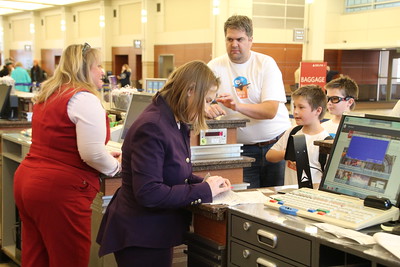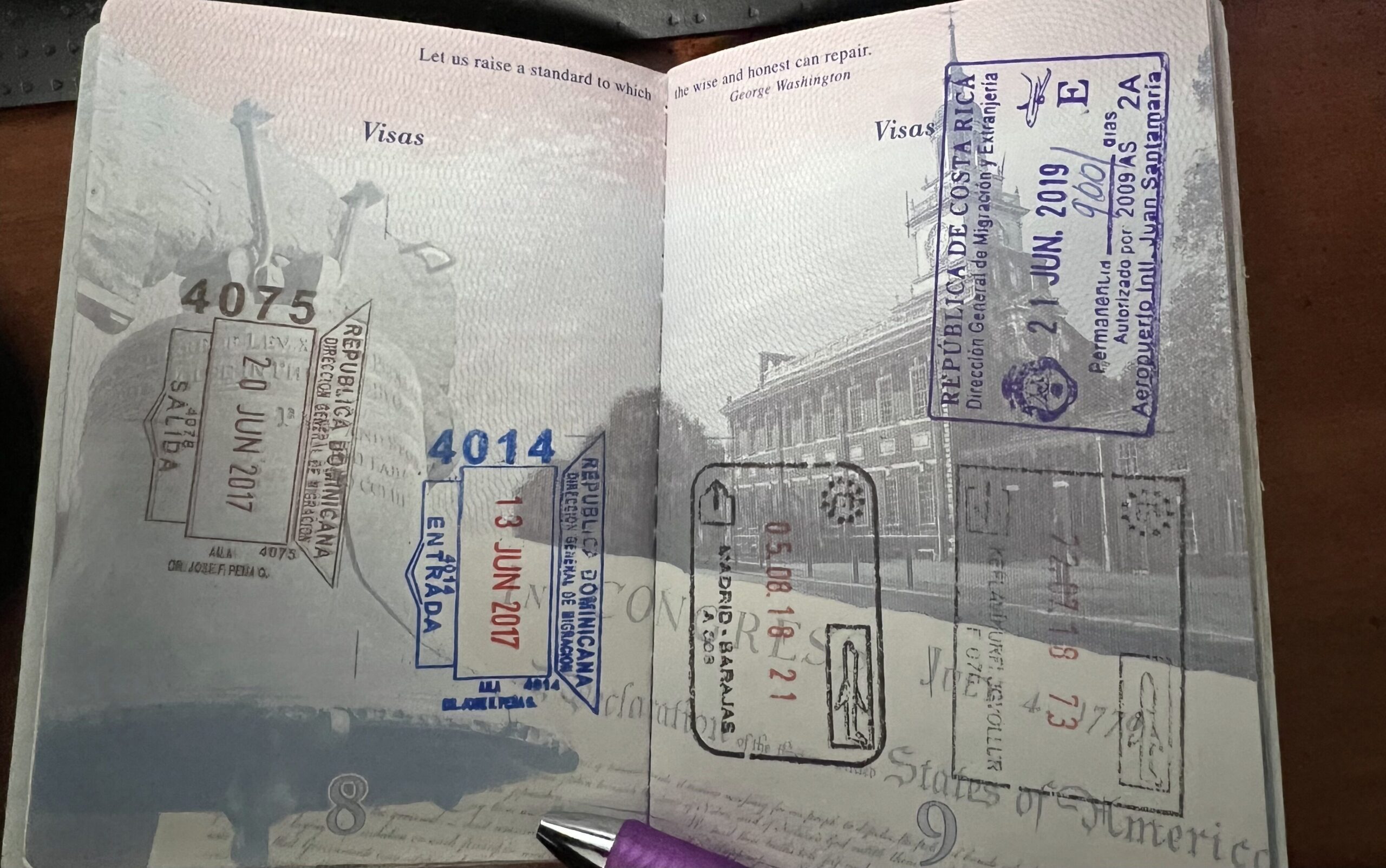This post won’t cover all of the ways to pack and to smooth out your airport experience, but hopefully it helps you know what to expect when you arrive at the airport.
Arriving:

When you arrive at the airport, especially if traveling in a large group, or for a long time, it’s likely you’ll get dropped off at the departures door. Most airports have these labeled with the airlines that are located inside those doors…although once inside it’s just one long hallway, so you can get from one to another if you use the wrong door.
Larger airports typically have multiple terminals. At O’Hare Airport in Chicago (the one I use for my international flights) there are 5. The airline I typically use (Iberia) departs out of Terminal 3. Many others depart out of Terminal 5. That is also where all international arrivals come in.

If you’re checking in for a flight and don’t have your own ticket (like it’s a group ticket situation) you’ll need to all go to the counter together. There, the counter agent will check your IDs, get you your boarding passes, and check in any checked baggage you all may have. They will direct you toward the TSA security area.
TSA Security Check:
As you enter the security check area, pay attention to what line you go in. There are a few programs like TSA Pre✔ that only allow their members through special (often faster) lines. It’s likely that even if someone in your group normally flies through one of these programs, if you did the tickets as a group, you’ll not be able to use those lines.
As you get into line, notice there are garbage cans nearby. You’ll want to ditch your coffee cup or water bottle if they’re disposable & still have liquid. Otherwise you’d better chug-a-lug. Got on a belt? Take it off and put it in your bag. Did you wear high-top shoes/boots that are a project to untie? Start loosening. Be ready to lose your jacket/baggy sweatshirt. Empty your pockets and stash all that small stuff in your bag. Watch the people in front of you who look like they know what they’re doing.
First you’ll approach an officer who will check your boarding pass and your ID (Passport if you’re in an international terminal) to make sure you’re supposed to even pass through the security are to begin with. That officer or another will then point you toward a line for the check. Here you’ll see a bunch of gray or white (or maybe a fun other color) bins. Odds are an officer will be walking around repeating instructions. Some airports have different technology so they may require less than this but the standard is:
- Any electronics larger than a phone (Laptop, tablet, e-reader, chromebook, handheld game console) need to be out of your bag and in a bin.
- Shoes in the bin.
- 3-1-1 liquids bag (quart-sized bag with 3.4oz or smaller containers) in the bin.
- Jacket or sweatshirt in the bin. They will make you take off a baggy hoodie or something like that.
- Empty your pants/shirt pockets and put all the contents in the bin.
You will probably need more than one bin.
After you bin your things, you send your bins down the conveyor belt to be x-rayed. The x-rays are not always super precise, so don’t worry if they need to back it up and look at something again, or if they pull it off to look more closely by hand. Some innocent things look oddly similar to prohibited things, so they need to check.
While your bag is being x-rayed, you will also be scanned. You may walk through a metal detector or through a body scanner. If you are not comfortable with that, or if you use a wheelchair or other mobility device, or if have something like an insulin pump that you can’t remove but would mess with their imaging/equipment, an agent of your same gender can pat you down by hand. Non-binary folks, I don’t have updated information on how this is handled, I would suppose you get to specify?
They may swab the handles of your bag, or ask to see something in your bag–I once had a cutlery set with a small butter knife, but because it was kind of pointy at the end, they confiscated it. Got to keep the spoon and fork though.
After security:
Now the waiting. Hopefully you arrived in plenty of time you don’t need to sprint to your gate. I always make my whole group find the gate first, set down things, and then everyone can go explore the concourse. There are restaurants, cafes, and stores. You’re not gonna get a bargain, but you can get a snack, buy liquids (it’s after security check), fill your water bottle, pick up last-minute things you didn’t get already, use the restrooms, and relax. Just know: your flight will probably begin boarding like 40 minutes before your departure time. Check your boarding pass…and always assume they’re gonna start early. They might start late, of course, but it’s better to be at the gate and bored a bit than to have them page you through the concourse because they were ready and you’re not there. Nobody wants to be the person that holds up a whole airplane.
Sometimes, on smaller planes or if you’re at the end of the line, you will be asked (told) to gate-check your bag. This will take your carry-on and check it like a larger suitcase. There is no charge for this. If it happens it means the overhead compartments are getting really full and you may not find a space on board for your bag. If you have your most important stuff in your personal item, this shouldn’t be a terrible thing…just make sure your most valuable things stay with you.
Boarding the plane:
Looking at your boarding pass, you’re usually assigned a boarding group. Pay attention to announcements at the gate for when it’s time to board. Get in line, and have your boarding pass handy for them to scan. As you enter the plane, find your seat. Your larger carry-on bag can go in the overhead bin. Hopefully you find space above your seat. If at all possible, try to NOT put it above the seats behind you. That is the WORST to get your bag back at the end of the flight. If you have a small personal item, like a backpack, this should go under the seat in front of you.
During the flight:
During takeoff and landing there are rules about seat belts and keeping electronics off. Listen to the announcements and signs on board, and the directions of the cabin staff. Did you know it’s actually a federal offense to not obey instructions of your flight attendant? That means all those people you see going viral losing their minds on flights because they don’t want to follow directions–they’re likely facing charges! When the seatbelt light goes off, you’re allowed to get up and walk in the aisle to stretch your legs or get to the bathroom, but mostly you should stay seated with your seatbelt fastened, in case of turbulence. Crew will announce when you can turn electronics back on (in airplane mode). Cellular network use is not allowed, but you can use in-flight WiFi (sometimes for free, sometimes for a fee)…but it is NOT high speed and you won’t be able to stream things, just check email, maybe work on google docs).
Near the end of the flight, the cabin crew will hand out immigration/customs forms to fill out. These vary slightly by country, but all look for basically the same information: who you are, why you coming here, where you’re going to be, and what you are bringing. Fill this out ACCURATELY. If you declare you have food, they may throw it out if what you brought is not allowed. If you say you don’t have food, but you do, and they catch it, you can face some pretty hefty fines.
Landing & De-plane-ing:
Settle down. The minute the wheels hit the ground, many travelers are gearing up to sprint for the exit. Of course it might be 20 minutes before the plane comes to a complete stop at the gate, and the jet bridge is in position to open the plane doors. It’s more comfortable to remain seated than to stand awkwardly, hunched over under the overheads, waiting for the traffic in front of you to leave. When it’s time, grab your carry-on bag carefully so you don’t bean someone else in the head, and head out of the plane. Be sure to thank the flight crew.
Immigration:

You will walk a distance that feels like forever to get to immigration/passport control. There are often separate lines for people with different types of passports. Heading into the US, for example, there are separate lines for US citizens/permanent residents and visitors. In Europe there might be a line for EU residents, regardless of nationality. Go to the line that fits you. These signs are always multi-lingual, often in the local language, English, and Chinese. The specific languages depend on what languages most often present themselves at that airport. Here you’ll wait in a checkout line until you’re called by an officer, to whom you’ll hand your passport & immigration form from the airplane. They’ll probably ask you a few questions to verify your information. Some agents are friendlier, others are more no-nonsense. This is where you get the cool stamp in your passport. Which also is proof you’re in that country legally. In my image you can see I got stamped in the Dominican Republic entering and leaving. Not every place stamps when you leave.
Baggage Claim:
Of course, if you only have a carry-on bag, you’ll be able to breeze right past baggage claim, but if not, you’ll need to find the carousel for your flight. The nice thing about the long passport check process is that there usually isn’t much of a wait, if any, for your bag. Grab it, and head to customs.
Customs:
This is where they make sure what you’re bringing into the country is allowed in the country. Sometimes customs will sort you into “things to declare” and “nothing to declare” lines. Sometimes there is just a line. (That has been my experience coming back to the US through Chicago, there is just one kind of line.) Things to declare basically means you checked “yes” to any of the questions on the form. This doesn’t mean you can’t bring the thing. Just that you need to declare it. For example, food. You have some cookies, candies, or chips? That is gonna be fine. But it is food and you need to declare. Meats or fruits or things like that will probably be taken. This is to prevent possible bacteria or pests from entering the local ecosystem. Again, if you have it, and didn’t declare it, you could face some serious fines (like hundreds of dollars).
That’s it!!
You’re done! Time to meet your courier or hotel shuttle or whatever you itinerary includes.
No responses yet